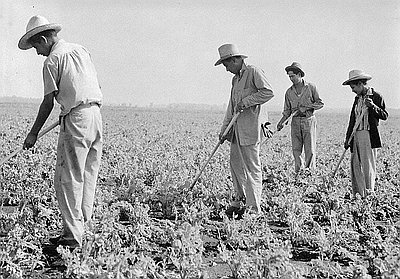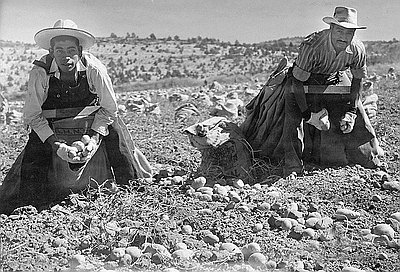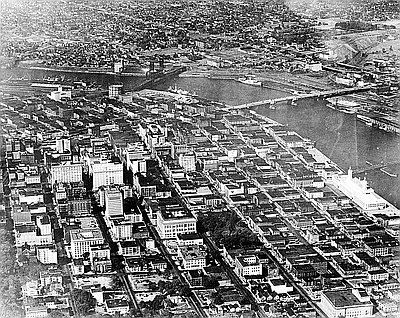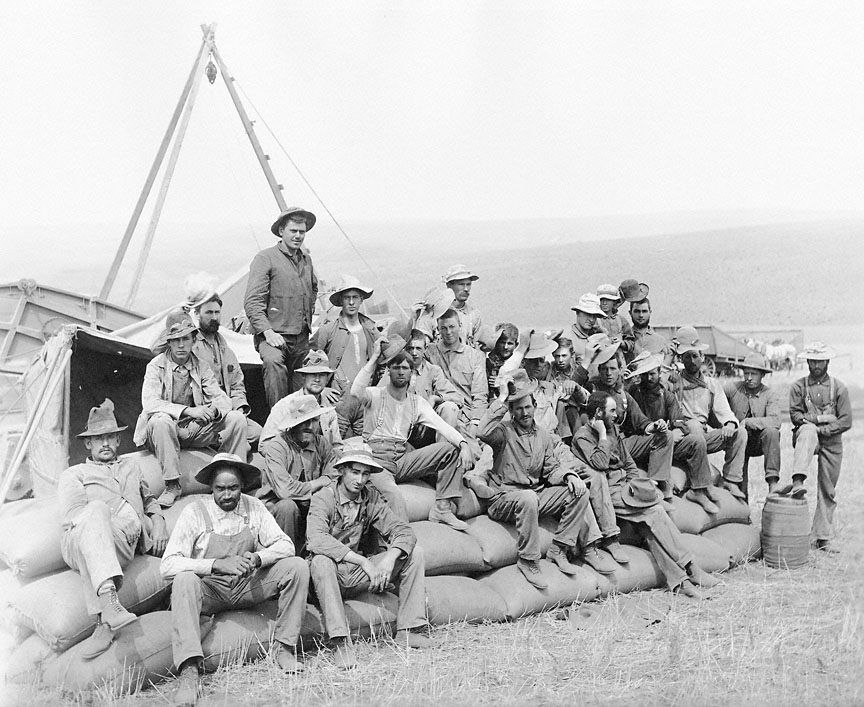- Catalog No. —
- OrHi 6337
- Date —
- c. 1900s
- Era —
- 1881-1920 (Industrialization and Progressive Reform)
- Themes —
- Agriculture and Ranching, Black History, Labor, Race, Ethnicity, and Nationality
- Credits —
- Oregon Historical Society
- Regions —
- Northeast
- Author —
- Will Raymond
Harvest Hands Rest on Sacks of Grain, Moro
This photograph shows harvest hands seated on sacks of grain near the northeastern Oregon town of Moro. It was taken by Moro photographer Will Raymond probably some time in the first decade of the twentieth century.
Thousands of itinerant workers roamed the Pacific Northwest in search of work during the late nineteenth and early twentieth centuries. Always on the move, they found temporary employment in mines, on railroads, in canneries, in the forests, and on farms and ranches. When between jobs, they often congregated in the towns, gambling, drinking, and patronizing the local brothels.
The “wageworker’s frontier,” as historian Carlos Schwantes has called the world of itinerant workers in the Pacific Northwest, was overwhelmingly male, though the ethnicity of the workers varied. Some were native born white Americans, others were immigrants from Europe or Asia. Native Americans also worked as itinerant wageworkers, as did African Americans, as evidenced by the photo above. These diverse groups sometimes worked side-by-side, though work forces were more often segregated, with non-white workers earning less than white workers.
Regardless of one’s ethnicity, life as an itinerant worker was far from easy. Many nights were spent sleeping outside, and men often had to resort to stealing from fields and orchards in order to keep their stomachs full. Work, when it could be found, involved long hours of backbreaking physical labor. Twenty-year-old Hayes Perkins, who spent most of 1898 wandering the Pacific Northwest in search of work, described working as a harvest hand near Colfax, Washington. He and his fellow workers labored from three in the morning until nine or ten at night. “When we complain,” he wrote in his journal, “it’s always ‘Oh boys, everything will be fine next year!’ which does not satisfy much.” Perkins concluded that “a hired man is but a domestic animal in this western country.”
The low pay and long hours contributed to the political radicalization of many itinerant workers, some of whom joined militant unions like the Knights of Labor or the Industrial Workers of the World. Schwantes concludes that “conflict between labor and management characterized the wageworkers’ frontier, as it did industrialized areas of the East—but with the added volatility of frontier ideals of individualism and personal advancement clashing with the dependency inherent in working for wages.”
Further Reading:
Hayes, Perkins. “Here and There: An Itinerant Worker in the Pacific Northwest, 1898.” Oregon Historical Quarterly 102, 2001: 352-376.
Schwantes, Carlos A. Hard Traveling: A Portrait of Work Life in the New Northwest. Lincoln, Nebr., 1994.
Schwantes, Carlos A. Radical Heritage: Labor, Socialism, and Reform in Washington and British Columbia, 1885-1917. Seattle, Wash., 1979.
Written by Cain Allen, © Oregon Historical Society, 2005.
Related Historical Records
-
Mexican Laborers Weed Sugar Beet Field
This photograph shows Mexican citizens weeding and thinning in an unidentified sugar beet field in Oregon, probably in Malheur County, during World War II. In 1942, the United …

-
Mexican Laborers Pick Potatoes, 1943
This photograph shows Mexican citizens harvesting potatoes in central Oregon during World War II. In 1942, the United States government negotiated with Mexico to import workers in order …

-
Portland's Laboring Class
As a frontier city, Portland had always had many more adult men than women. The young men were usually unmarried and accustomed to moving from rural to urban …

